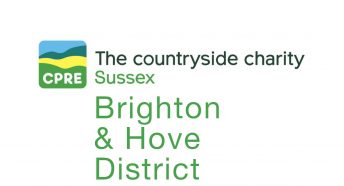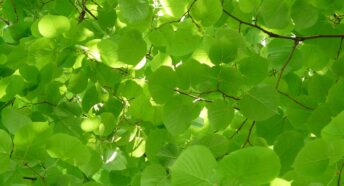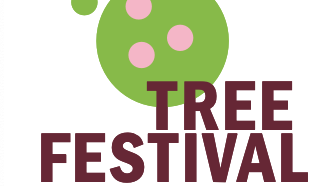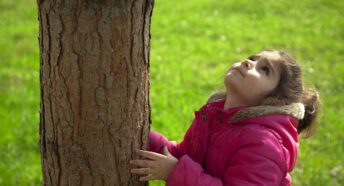Brighton & Hove District Update September 2019
Find out about the hard work and commitment of our volunteers in Brighton & Hove.
1. Increasing the Urban Tree Canopy
Plant your Postcode: – the big event this year for the Brighton & Hove Group was the launch on 20th June of our Plant Your Postcode project at the Hotel du Vin. The project aims to help local people get more street trees planted and cared for throughout the city. As well as being lovely to look at, trees have enormous benefits for the environment, tackling climate change and improving mental health and wellbeing. Go to https://plantyourpostcode.org.
The launch event was very successful with over a hundred people attending, including our supportive and knowledgeable panel of speakers. The launch was also featured on Meridian News and on BBC Radio Sussex. We have raised funds of over £10,000 for planting, and a crowd funding campaign has been launched to raise further funds – it is hoped that at least £20,000 will be raised through this and other donations: https://www.crowdfunder.co.uk/plant-your-postcode
Some of the grant funding we have received will help pay for planting in areas which currently have hardly any street trees, places like the Bristol Estate, Woodingdean and Moulsecoomb. We are working closely with the City Council, other national and local organisations and groups, including Hove Civic Society and the Brighton & Hove Green Spaces Forum, to ensure the project’s success and sustainability over time. The project is especially timely as concerns about our health and wellbeing mount and the Council declares a climate emergency.
Over the past ten years, austerity has severely limited Council budgets meaning few street trees have been planted to replace those felled as they succumb to disease and old age. Wherever you walk in the city the sight of stumps has become increasing common so it’s very welcome news that the Council has just recently allocated some funds towards the replacement of tree stumps with new planting throughout the city. We will be supporting the Council to plant many more trees from a range of different species to reduce our dependency on the few species currently lining our streets. Not an entirely straightforward task with our difficult soil and coastal weather conditions!
Local members continue to monitor the condition of trees citywide and we have had requests from villages and towns throughout Sussex to extend the project, something we plan to explore once it is firmly established in Brighton & Hove.
If you’d like to become a supporter or get involved with the project we’d love to hear from you so please go to the website and follow the links: https://plantyourpostcode.org. As you will see there are plenty of ways you can get involved, such as:
- donating to ensure the long-term success of the project (a one-off donation of £445 will donate a street tree or £195 will fund part of a tree in a park or open space or set up a monthly standing order – just £5 per month to PYP would help fund our work with young people)
- getting together with other residents in your area to see if there is any interest in planting trees where you live
- volunteering – we are looking to build up a network of volunteers who would be happy to actively support residents’ groups participating in the scheme. We are also looking for people prepared to take on a small research project or who would like to be trained as a Tree Warden, keeping an eye out for the health of the trees in their local area (for more details see https://plantyourpostcode.org/2019/07/22/become-a-tree-champion).
Network Rail: healthy established mature trees are at risk of being felled too. For example in August, Network Rail felled the trees from a stretch of the railway line along Addison Road, Hove, to the fury of residents.
2. The City Fringes
Ovingdean: still on the subject of trees, our active members together with ORPS (Ovingdean Residents Preservation Society) are engaging with the local farmer to plant a native species hedge along Greenways – early stages yet but aiming for this year if all falls into place. This will be of huge benefit to wildlife linking the allotments and woods with the gardens and Nature Reserve. Nine trees were planted along the road this year and there are five more to add next year. Although rather exposed to sea winds they should thrive as the soil is good.
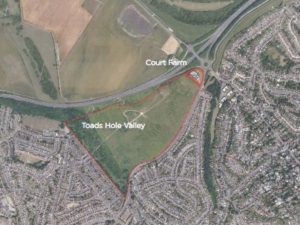
Toads Hole Valley: the group continues to monitor evolving development plans for the 98 acre greenfield site next to the South Downs National Park which was an Area of Outstanding Natural Beauty until 10 years ago. The site is entirely covered with a mixture of dense and scattered scrub and rough grassland with a small area of mature woodland present to the north. This supports habitats for dormice, slow worm and common lizard, and is a breeding ground for linnet, white throat, song thrush, dunnock and yellowhammer to name just a few of the birds frequenting the site.
The sites Biodiversity Checklist is poor as is the Ecological Constraints and Opportunities Plan. However, the vegetation on the main site has been assessed to be of ‘low botanical value’ meaning the entire area can be grubbed out if permission is granted. Consent would then exist for 880 dwellings and other development, without, in our view, proper evidence that the density proposed can be satisfactorily accommodated. (How can we condone demolishing this regenerating woodland whilst criticising fires in the South American rainforests?)
Surely concentrating on important specified wildlife subjects while still at the outline planning stage is paramount otherwise it will be too late to introduce ecological matters effectively, matters of prime importance which, all too often, appear to be given the lowest priority by landowners and developers.
CPRE local group are planning an inspection visit to THV this autumn as access is now permitted.
In addition, recent road widening plans involve taking land from Three Cornered Copse, thus reducing the size of the Conservation Area and The Conservation Advisory Group and the County Ecologist have objected to loss of vegetation from Three Cornered Copse due to the impact this would have on the efficiency of the proposed dormouse mitigation project. The current proposal also shows by King George VI Avenue. the key wildlife corridor to the Copse will be cut off NO wildlife access tunnel or bridge across the A27 (the Highways Department are responsible but are dragging their feet).
Proposals for the Local Wildlife Site would ‘restore the area to chalk grassland, scrub and woodland mosaic for the benefit of dormice, reptiles, invertebrates, bats and birds’. However, with wildlife access to and from the site cut off by the two major roads and the high density of development planned, it is very difficult to see how any wildlife is to be accommodated at all.
Local people are concerned about plans to reduce the speed limit to 30 mph on the main road, King George VI Avenue, and to introduce three sets of lights to control traffic flow at the developments three new roads joining it, inevitably increasing congestion in the area. This development does not go nearly far enough in tackling carbon emissions, especially those emitted by cars. This area is also an important water catchment area for Brighton.
A target of 40% of journeys to be made by walking or cycling is too low. People can and will make big changes to their mode of transport if the right infrastructure is in place. However, creating a wide cycle track through the Local Wildlife Site should not be considered and the Local Wildlife Site should not be touched while development is taking place – they are separate units. Why not set the doctors’ surgery in green space with plenty of bike racks trees and hedges in addition to required but minimal car parking?
Portslade and Coldean: these are progressing and are the first of Homes for Brighton & Hove proposed developments. Further sites are being investigated.
3. Green Space – in New Development and Links to Public Open Spaces
New Development – Retirement Village: MODA’s plans for a retirement village and mixed-use development on the brown field site near the junction of Sackville and Shoreham Roads near Hove Park was rejected. To fulfill the City’s five-year housing requirement there is great pressure on the Council to approve development of this scale.
However, care in designing public green spaces and planting in this development was very evident, with tree planting on and around the site maximized, softening the visual impact despite the density in contrast to other large central Hove developments.
However, councilors felt that the large high-rise blocks proposed towards the rear of the site were not in sympathy with the heritage area and were out of scale with the neighbourhood. Nor did the scheme provide truly affordable housing. It was also felt it would have a negative impact on the Park and surrounding areas. We expect a modified proposal to be put forward.

